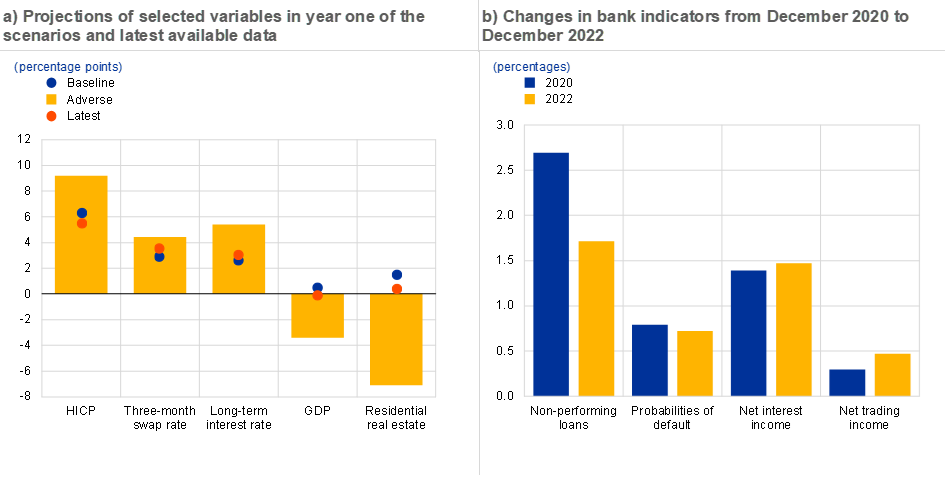
2 August 2023
Policymakers should focus on preserving bank resilience to strengthen macroprudential stability at a time of economic uncertainty. This would ensure that sufficient capital buffers are available should widespread losses arise, argues ECB Vice-President Luis de Guindos.
European banks are in reasonably good shape. Despite the pandemic and the war in Ukraine, they have improved their profitability and the quality of their assets. They would be strong enough to withstand a severe economic downturn, as shown by the results of the 2023 stress test carried out by the ECB in coordination with the European Banking Authority.[1] The test includes a scenario with high and persistent inflation, higher interest rates and a severe economic recession. Even under this adverse scenario, most banks continue to meet their minimum capital requirements. The stress test also provide broader insights about our financial system. We should take a closer look at the key risks that banks face when interest rates rise[2] and draw the right conclusions for macroprudential policy.
But first, some background: the exercise tested banks’ balance sheets under two scenarios. The baseline scenario uses the December 2022 Eurosystem staff macroeconomic projections for the euro area.[3] The adverse scenario, meanwhile, sees worsening geopolitical tensions that lead to stagflation and rising rates, and a prolonged period of low growth (Chart 1, panel a). So how well prepared is the banking sector for a shock of this kind?
Chart 1
Selected scenario variables and bank indicators at the start of the exercise

Sources: ESRB scenario, EU-wide stress test submissions, Eurostat, Statistical Data Warehouse and ECB calculations.
Notes: In panel a) HICP stands for Harmonised Index of Consumer Prices. In panel b) net interest income is scaled by total assets and net trading income by risk exposure amounts. All indicators are weighted by risk exposure amounts.
Banks are relatively strong in the baseline scenario
Banks’ balance sheets were in much better shape at the start of the 2023 stress test than they were two years earlier. By the end of 2022, banks had improved the quality of their assets and increased their profits compared with 2020 (Chart 1, panel b). Despite the Russian invasion of Ukraine and the commodity crisis, they reported that the financial positions of their customers – both households and corporates – were stronger. The banks’ non-performing loan ratio fell from 2.7% in 2020 to 1.7% in 2022, and they saw an increase in their net interest income over the same period.[4]
Under the baseline scenario, this positive trend continues. Net interest income grows further as market rates increase and inflation gradually falls. Banks that see a faster repricing of their assets and that are less reliant on market funding earn more. Credit risk losses only increase at a moderate pace. Overall, the banking sector’s Common Equity Tier 1 (CET1) capital, the highest quality of capital, increases by approximately €160 billion in the baseline scenario. The majority of banks easily meet their existing capital requirements. They would even be able to strengthen their capital positions.
Some banks would be vulnerable to a severe shock
The picture is gloomier in the adverse scenario. Inflation remains high and persistent, real estate markets deteriorate and tensions emerge in sovereign bond and financial markets. The CET1 ratio of stressed banks drops by 478 basis points.
In the adverse scenario, banks representing 60% of the assets covered by the exercise fall below the maximum distributable amount (MDA) trigger[5] – the level of capital requirements and buffers banks need to reach to avoid restrictions on their dividend payments. If their capital ratios approach or breach this threshold, banks may start to reduce their lending procyclically. At bank level, the breaches appear to be related to the low starting point of the banks’ capital levels or to their inability to generate net income in the adverse scenario. But the extent of the breaches differs. In some countries, banks falling below the MDA trigger represent as little as 2% of the assets covered by the stress test. In other countries, all the banks tested would fall below the MDA trigger.
Some banks appeared to fare better than others in the adverse scenario. This is due to several factors which are key to weathering the severe, unexpected shock. For example: their capacity to generate income, which depends on their asset liability management and repricing structures; their smaller reliance on wholesale funding, which is more expensive in a stress scenario; their cost efficiency which plays an important role in mitigating the negative effects of the inflationary environment projected in the adverse scenario; and, finally, their hedging strategies against interest and credit spread risk which have become more effective since the last stress test.
We also assessed, for the first time, the potential losses that banks could incur on their bond holdings booked at amortised cost.[6] Those losses would only materialise under extreme circumstances – for example if banks were forced to liquidate these holdings. The data provide some insights into how banks’ economic value of equity evolves under the EBA’s adverse scenario for market risk.
Overall, the exercise paints a reassuring picture. At February 2022, the unrealised losses of the banks tested were small in comparison with their international peers. The additional losses incurred on these portfolios in the adverse scenario were also contained. Such losses would be driven predominantly by the widening credit spreads, as banks hedge themselves more against interest rate increases.
Preserving resilience by maintaining macroprudential buffers
So how will these results inform our macroprudential policy?
Under the baseline scenario, most banks remain profitable and accrue capital. All banks meet their minimum and Pillar 2 capital requirements, and no bank breaches its MDA trigger. Against this backdrop, macroprudential policy should focus on preserving banking sector resilience.
We should ensure that existing macroprudential capital buffers are not released. Targeted increases in capital buffers could still be considered in certain countries with vulnerabilities, as long as the risk of procyclicality remains low. [7]
The finding that some countries’ banking sectors would experience material widespread losses if the adverse scenario were to materialise adds relevant information to these discussions. From a financial stability perspective, capital should not flow out of the system, and banks should maintain a prudent approach to dividend payouts.
In the situation that the adverse scenario were to materialise, what should our macroprudential policy response be? A buffer release would be warranted if widespread losses occurred and there was a tightening of credit supply owing to capital constraints.[8] The buffers built up since the pandemic could be released, which would help banks to absorb losses while still providing key services to the economy.
Overall, the stress test confirms European banks could withstand a severe economic downturn. However, as this is a supervisory stress test, which assumes that the balance sheets of the participating banks remain constant, it does not look at how banks could react to the adverse scenario, such as by cutting back on lending. We will be considering this potential adjustment as part of our macroprudential stress test, the results of which will be published in the autumn.





